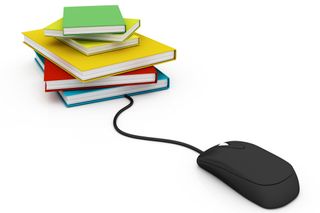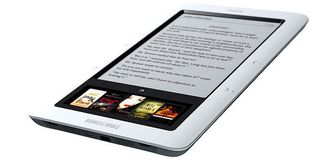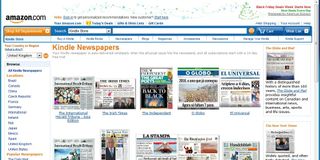Are e-books and tablets the future for print media?
As Wired unveils its new look for tablets, will such devices be enough to save magazines and newspapers?

Some are calling it the year's hottest Christmas gadget. Others are suggesting it's the future of publishing. Whatever you think, e-book readers are big news this year.
Amazon's Kindle has become the best selling product on the Amazon.com website, and its hobbling of the International version for the UK market hasn't stopped it being talked about in just about every broadsheet newspaper and lifestyle magazine in the land.
Analysts at Forrester Research expect three million e-book readers to have been sold during 2009 in the US alone, with 900,000 of those selling within November and December.

And that's just the start. With Kindle rivals like the Plastic Logic QUE and the Barnes and Noble Nook adding new features, larger, touch sensitive screens and secondary colour displays to these devices, e-books should be even bigger in 2010.
Tablets on the way
Yet the current wave of e-book readers might only be the appetiser for the real next-generation of media devices. Few products of recent years have achieved the mythical status of Apple's rumoured Media Tablet or Slate - a full-colour, video-capable device that apparently resembles an iPod Touch with a 10.7in touchscreen, connected to the internet via 3G and/or Wi-Fi.
According to sources from the Sydney Morning Herald and a slip from an the New York Times, Apple has been demonstrating the device to prospective media partners around the globe.
Get the ITPro. daily newsletter
Receive our latest news, industry updates, featured resources and more. Sign up today to receive our FREE report on AI cyber crime & security - newly updated for 2024.
If the Apple Tablet ever does launch, it won't have the market to itself. Earlier this month, Creative Labs used its annual general meeting to announce a Mediabook', a similar colour tablet-like device featuring a colour touchscreen and internet capabilities.
Details have been leaked of a prototype Microsoft device, codenamed Courier, which boasts dual seven-inch touchscreens and advanced media and web browsing features.
From announcements made by magazine giant Conde Nast, we also know that HP is working on a media tablet of its own.
While these next-generation devices might not be able to match the battery life of the e-ink powered Kindle, and will certainly arrive at a higher price point, the lure of colour, rich content, video playback and internet features may be enough to make that seem worthwhile.
Salvation for newspapers?
This is all very interesting, and book publishers around the globe are rubbing their hands with glee at the thought of more e-books being sold. However, it's publishers of newspapers and magazines who potentially have the most to gain from the sales of these devices.
The global recession, plummeting newspaper sales and the slide in advertising revenue has brought the old debate in the publishing industry over free vs paid for content on the web to a new head.
Earlier this month, Rupert Murdoch announced that News Corporation would introduce fees for access to content on its sites, including those of The Times, The Sun, The New York Post and The Australian: "There's not enough advertising in the world to make all the websites profitable... We'd rather have fewer people coming to our websites but paying."
Even rivals who have stated a desire to retain free content are admitting that something has to change. The Guardian Media Group, for example, has suggested that while the core content of the Guardian.co.uk website would remain free, the company's B2B titles and specialist sections, such as MediaGuardian.co.uk, might eventually move to a paid-for model.
Paying up
This is where e-books and the new breed of media tablet come in. It's hard to persuade an audience that's used to getting free content on the web to pay up.
It's easier, however, when you ask them to pay for content in a different format on a new device.
There is evidence, too, that people are prepared to pay for the right content. They might not, for example, be prepared to pay for a news story that they can get for free from the BBC, but they may be willing to pay for specific columns, features or analysis.
This month, a survey by Continental Research claimed that while only 37 per cent of those questioned would be willing to pay for content, 21 per cent would be willing to use micropayments for columns by the likes of Jeremy Clarkson, Charlie Brooker or Giles Coren.

Alternatively, publishers could adopt a subscription model a model Kindle is enabling today. Several UK dailies, including The Independent, Daily Mail, Telegraph and Times, are already available for a monthly Kindle subscription, alongside The New York Times, The Washington Post, International Herald Tribune and Le Monde. The same goes for such magazines as The Spectator, Time, Newsweek, Fortune and The New Statesman.
Not there yet
Here, however, the Kindle and the current generation of devices have their limitations. Not all content is necessarily included in the digital editions, and images and tables either get stripped out, or prove virtually unreadable. "To date, no newspaper has worked well on a device," says Allen Weiner, a research vice president for Garner. "A newspaper on a Kindle is a horrible experience. Everybody knows it."
With the next-generation media tablets, this might not be the case. Rupert Murdoch has talked of Kindle as the first inkling' of a new business model for newspapers, but not the end product.
When the global media magnate described his vision of a media tablet to the Fox Business channel earlier this month, he talked of a "reasonable size, attractive tablet in full colour, and you could read a newspaper on it."
In a briefing at The New York Times, executive editor Bill Keller discussed the need to "figure out the right journalistic product to deliver to mobile platforms and devices" and his desire to "get the newsroom more actively involved in the challenge of delivering our best journalism in the form of Times Reader, iPhone Apps or the impending Apple slate, or whatever comes after that."
Allen Weiner admits to having seen prototypes of unspecified media devices under non-disclosure agreements, and would go so far as to call them "better. Not great, but better."
Magazines get wired
Magazines, too, have their challenges. Weiner notes that the key problem for digital editions of magazines has always been in creating a compelling experience, and in retaining the style and the values of the brand.
For magazines to work on an electronic device, that device needs to support colour, and it needs to provide an equivalent or superior experience, in terms of content and layout, to what is possible on paper. Here the tablet can help.
"Magazines have an opportunity in these devices," Weiner says, though "it's going to take a little longer to figure out what the right experience and the right business model is."
Conde Nast is certainly heading in this direction. The publisher behind Vanity Fair, Vogue, GQ, Wired and Tatler has already announced its attention to make its magazines available to a range of devices, including laptops, smartphones and, to quote the press release, "the upcoming electronic colour slate devices."
The magazines will operate on an Adobe software platform, built partly on specifications for an upcoming tablet from HP. According to the publisher, this platform will deliver "full-colour, high-resolution magazines that combine the immersiveness of its award winning titles with the convenience and functionality of a digitally distributed and internet-connected product."
Wired will be the first of the publisher's titles to take this route, in a format that allows readers to flip through pages, zoom into images and even launch videos. In other words, you get something that looks and feels like a magazine, but potentially gives a little more.
That's a pretty compelling proposition, and one that other publishers will want to match. Media giant Time Warner is rumoured to be putting together a new digital storefront and distribution platform for the new breed of digital magazines.
One of company's new media gurus, Josh Quittner, is also known to be working on prototype digital magazines, and wrote on his blog: "I think it's conservative to say that in the miserable publishing business, there is no greater hope for salvation than the iThing. With visions of giant iPhones dancing in our heads, all of us are working on prototypes of magazines and newspapers that will work on 9.7-inch, multi-touch screens linked wirelessly to stores."
Allen Weiner adds a note of caution, particularly when it comes to newspapers. "Newspapers are chomping at the bit to make this work, but it's not going to be nearly as easy as they hope," he said.
However, the fact that these tablet devices can offer a more rich and dynamic user experience could make them the unlikely saviour of print publishing. "Both newspapers and magazines benefit hugely from tablets, because it gives them more real-estate, more connectivity and bandwidth to do more things," he added.
Tablet future?
The problem for Kindle and the basic e-book reader, Weiner suggests, is that it doesn't provide any more compelling experience of a magazine or newspaper than the web provides for free.
The tablet, however, has more potential. "Until the tablet takes off and is popularly priced, and is built on a business model that works, I think it's going to be a challenge," he said.
"When that happens, I think the tablet could be the newspaper and magazine's best friend."
Stuart has been writing about technology for over 25 years, focusing on PC hardware, enterprise technology, education tech, cloud services and video games. Along the way he’s worked extensively with Windows, MacOS, Linux, Android and Chrome OS devices, and tested everything from laptops to laser printers, graphics cards to gaming headsets.
He’s then written about all this stuff – and more – for outlets, including PC Pro, IT Pro, Expert Reviews and The Sunday Times. He’s also written and edited books on Windows, video games and Scratch programming for younger coders. When he’s not fiddling with tech or playing games, you’ll find him working in the garden, walking, reading or watching films.
You can follow Stuart on Twitter at @SATAndrews.





